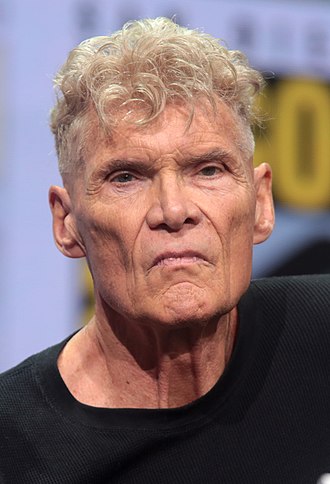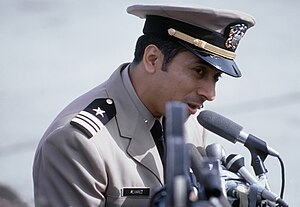Discover Your Roots
SIGN UPDiscover Your Roots
SIGN UPEverett is a male given name of English origin, meaning "Wild Boar Herd." This strong and masculine name has a rich history and is associated with qualities of leadership and strength. The name has been borne by notable individuals across various fields such as arts, business, film and television, politics, military, sciences, sports, and more. Its significance is deeply rooted in English culture and holds a sense of power and resilience. The name Everett resonates with individuals seeking a name with historical significance and a strong, commanding presence.

Everett McGill, born on October 21, 1945, is a retired American actor who gained recognition for his role as a caveman in the film Quest for Fire (1981), followed by notable performances in Dune (1984), Silver Bullet (1985), Heartbreak Ridge (1986), Iguana (1988), Licence to Kill (1989), The People Under the Stairs (1991), and Under Siege 2: Dark Territory (1995). He also portrayed "Big" Ed Hurley in the television series Twin Peaks (1990–1991) and reprised the role in the show's revival. McGill, known for playing sadistic military types or terrorists, has collaborated frequently with director David Lynch, appearing in Lynch's works such as Dune and The Straight Story. Despite retiring from acting in 1999, he made a comeback for the Twin Peaks revival. McGill's career also includes roles in Brubaker, The Guiding Light, and My Fellow Americans. With a relatively concise filmography, McGill's impact on the entertainment industry remains noteworthy, especially through his collaborations with acclaimed directors and his memorable portrayals in various films and television series.

Everett Alvarez Jr. is a retired United States Navy officer who endured one of the longest periods as a prisoner of war (POW) in U.S. military history. Born in 1937 in Salinas, California, Alvarez is the grandson of Mexican immigrants. He joined the U.S. Navy in 1960 and was the first U.S. pilot to be shot down and detained during the Vietnam War. Alvarez spent over eight years in captivity, enduring brutal treatment at the hands of the North Vietnamese. Upon his release in 1973, he continued his military career, earning a master's degree and retiring from the Navy in 1980.Post-military life saw Alvarez appointed to various government roles, including Deputy Director of the Peace Corps and Deputy Administrator of the Veterans Administration. He also founded Alvarez LLC, an IT consulting firm, and has been involved in numerous organizations and committees, including the Vietnam War Commemoration Advisory Council.Alvarez’s contributions have been recognized with numerous honors, including the Congressional Gold Medal and the naming of the USS Everett Alvarez in his honor. He is married to Thomasine Ilyas and has two children.Alvarez's remarkable story of endurance, service, and leadership continues to inspire and his legacy is commemorated through various schools, parks, and awards named in his honor.

Everett Shinn (1876-1953) was an American painter and a prominent member of the urban realist Ashcan School. Known for his ability to depict animated movement, Shinn's work defied traditional art conventions and focused on robust images of real life. His preferred medium was pastels, and he was renowned for his scenes of disaster, street violence, and theatrical subjects. Shinn's talent was recognized early in his childhood, and he pursued formal art education in Philadelphia and New York City. He was part of the vibrant art scene and social circles, collaborating with influential artists and illustrators of his time. Despite financial challenges during the Great Depression, Shinn continued to exhibit and receive accolades for his innovative paintings. His life and career were marked by multiple marriages and tabloid rumors, adding to his enigmatic persona. Shinn's legacy is intertwined with the achievements of the Ashcan School, and he is remembered as a pivotal figure in American art history. He passed away in 1953, leaving behind a body of work that continues to inspire and captivate art enthusiasts.

Everett M. "Ev" Rogers, an American communication theorist and sociologist, is renowned for originating the diffusion of innovations theory and introducing the term "early adopter." Born in 1931 in Carroll, Iowa, Rogers initially had no plans to attend university, but after visiting Iowa State University, he pursued a degree in agriculture, later earning his M.S. and Ph.D. in rural sociology. Throughout his illustrious career, Rogers held faculty positions at various esteemed institutions, authored over 30 books and 500 articles, and served in prestigious academic and leadership roles. His seminal work, "Diffusion of Innovations," published in 1962, became a widely acclaimed publication in the social sciences. Rogers' model categorizes adopters of innovations into innovators, early adopters, early majority, late majority, and laggards, providing a common language for innovation researchers. His research and work have greatly influenced communication, technology adoption studies, and various other social science studies, as well as practical health issues. Rogers' impact on the field of communication and sociology continues to be felt, solidifying his legacy as a pioneering figure in the academic world.

Everett G. Brown (January 1, 1902 – October 14, 1953) was an American actor known for his appearances in about 40 Hollywood films between 1927 and 1953. Despite often playing small and uncredited roles, Brown made a memorable impact with his portrayals of characters such as "Big Sam" in the classic film Gone with the Wind (1939) and the Native in an Ape costume in King Kong (1933). Born in Texas, he retired from the film industry in 1940 but made a brief return in 1949, starring in four more films before his passing. Brown's contributions to the silver screen left a lasting legacy in the hearts of movie enthusiasts. He is laid to rest in Evergreen Cemetery, Los Angeles.
All images displayed on this page are sourced from Wikipedia or Wikimedia Commons.We use these images under their respective Creative Commons or public domain licenses. Wherever applicable, author attributions and license information are provided. If you believe an image is used incorrectly or outside its license terms, please contact us so that we can review and correct the issue.